Contents
- What does asparagus look like and how does it taste?
- The chemical composition and calorie content of asparagus
- Benefits of asparagus: 11 reasons to include it in the diet
- 1 Asparagus provides the body with antioxidants
- 2 Asparagus improves digestion
- 3 Has antihypertensive properties
- 4 Asparagus helps in weight loss
- 5 Asparagus helps fight urinary tract infections
- 6 Provides the body with valuable vitamin E
- 7 Helps manage hangover symptoms
- 8 Asparagus fights bloating
- 9 Is an excellent source of vitamin K
- 10 Asparagus is good for stomach ulcers
- 11 Asparagus is a great mood booster
- How to cook delicious asparagus?

In botany, various representatives of the asparagus family are described. They are united by the external similarity of twigs covered with thin, soft leaves, rather resembling needles. Asparagus has found application in cooking and medicine due to its taste and unique beneficial properties. Florists value plant branches as a wonderful decoration for bouquets.
Quite often, consumers confuse asparagus with soy asparagus, green beans and other plants. In this article, we will understand the taste and nutritional characteristics of asparagus, evaluate its medicinal properties and answer many other questions.
What does asparagus look like and how does it taste?
Asparagus is a herbaceous plant that is also called asparagus. Adult culture is a lush, branched shrub, reaching one and a half meters in height. Its young shoots look like miniature spears, the color of which differs depending on the variety. On sale are sprouts no more than 20 cm, collected in bunches.

Asparagus is characterized as the first spring vegetable, which gives a lot of useful substances during the period of seasonal hypovitaminosis. The first crop is harvested in the first days of April. Young shoots of asparagus are characterized as a delicacy product with a delicate taste. Depending on the variety, asparagus can have earthy, nutty or truffle notes, hints of broccoli or peas. Recipe features allow you to enhance the taste of the plant. Properly cooked asparagus retains its crunchy texture.
Soy asparagus – how is it different from regular asparagus?

As we said above, real asparagus is the young shoots of the asparagus plant. They are straight, with a smooth surface, quite dense. They can be white, green or purple. Real asparagus is a nutritious product containing a lot of vitamins and microelements.
Soy asparagus (or fuju) is a Korean food made from the milk of soybeans. When soy milk is boiled, foam forms on its surface. It is collected, hung to dry. After drying, the product is cut and packaged. Soy asparagus is a semi-finished product. The taste of fuju rather depends on the accompanying ingredients – sauce, spices. It can become an alternative to meat, as it is considered a fairly nutritious product. However, fuju contains an extremely low content of nutrients. In this sense, she certainly loses the real one.
The chemical composition and calorie content of asparagus
Calories 20 KKal
- Fats:
0,1 g
- Proteins:
2,2 g
- Carbohydrates:
3,9 g
- Water:
93,2 g
- Ash:
0,6 g
- Cellulose:
2,1 g
Vitamins (in 100 g): | Quantity | %RDN |
Methylmethioninesulfonium (vitamin U) | 100-250 mg | 110% |
Vitamin K | 41,6 mcg | 35% |
Vitamin B9 (folic acid) | 52 mcg | 13% |
Lutein + Zeaxanthin | 710 mcg | 12% |
Vitamin B1 (thiamine) | 0,14 mg | 9% |
Vitamin E (alpha tocopherol) | 1,13 mg | 8% |
Vitamin B2 (riboflavin) | 0,14 mg | 8% |
Vitamin B3 (PP, nicotinic acid) | 1,43 mg | 7% |
Minerals (in 100 g): | Quantity | %RDN |
Silicon | 98 mg | 327% |
Rubidium | 28,5 mcg | 29% |
Bor | 19,1 mcg | 28% |
Copper | 190 mcg | 19% |
Sulfur | 190 mg | 19% |
Cobalt | 1,7 mcg | 17% |
Hardware | 2,14 mg | 12% |
Phosphorus | 52-97,2 mg | 10% |
Iodine | 15 mcg | 10% |
Full chemical composition ➤
Other important connections:
Phytosterols — 24 mg (43,6% of RDI)
Purine — 10 mg (8,3% of RDI)
The green parts of asparagus are rich in saponins, coniferin, chelidonic and succinic acids.
The study of the composition of young asparagus shoots showed a record content of asparagine, arginine. Lysine and carotene were found in small concentrations. Specific aspartic acid, which is present in large quantities in young shoots, causes a change in the smell of urine. Approximately 15 minutes after eating asparagus, the excreted urine acquires an unpleasant hydrogen sulfide odor. The rate of excretion of aspartic acid in all people is different, but on average it is about four hours.
Benefits of asparagus: 11 reasons to include it in the diet
1 Asparagus provides the body with antioxidants
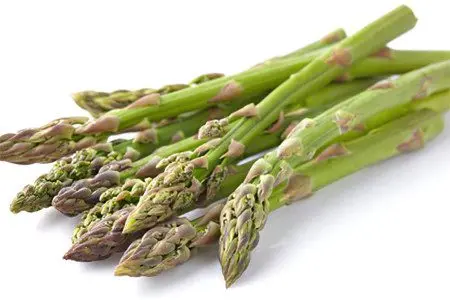
Asparagus contains several compounds known to have antioxidant properties, including glutathione, flavonoids, polyphenols, vitamin E, and ascorbic acid. As the study of the composition showed, asparagus is a rich source of quercetin, isorhamnetin, kaempferol [1].
It has been established that the listed biochemical compounds are able to have anti-inflammatory, antiviral, hypotensive, antitumor effects on cells. Evidence-based studies have been conducted both in test tubes and on animals and humans [2], [3], [4].
The analysis showed that in purple asparagus there are much more anthocyanins – pigments that give a characteristic color and implement an antioxidant effect on the cells of tissues of internal organs. [5].
Regular consumption of foods containing anthocyanins helps maintain normal blood pressure, reduce the likelihood of heart attacks, the development of diseases of the heart and blood vessels.
Introducing asparagus into your daily diet, pairing it with vegetables and fruits, provides you with the antioxidants you need to improve your health.
2 Asparagus improves digestion
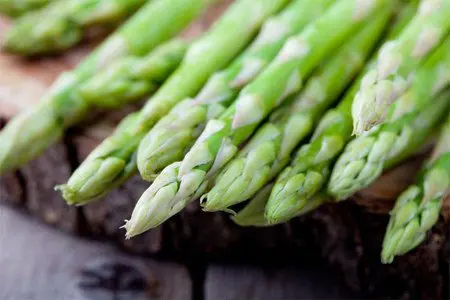
A half cup of asparagus contains almost 2 grams, or 7% of the recommended daily allowance of dietary fiber. A regular intake of fiber is necessary for the normal digestion of food.
Observations suggest that a diet rich in fiber is an excellent addition to traditional remedies for lowering blood pressure, preventing diabetes and heart disease. [6].
Asparagus contains a lot of insoluble fiber. Vegetable fiber normalizes and facilitates the process of bowel cleansing. There is some soluble fiber in asparagus shoots. Soluble fiber, combined with water, is converted into a gel-like mass, which serves as food for beneficial intestinal microflora – lacto and bifidobacteria.
Healthy intestinal microflora is necessary for the formation of immunity, the synthesis of vitamins K and B12. Asparagus is high in fiber, which means it can keep your digestive system healthy.
3 Has antihypertensive properties
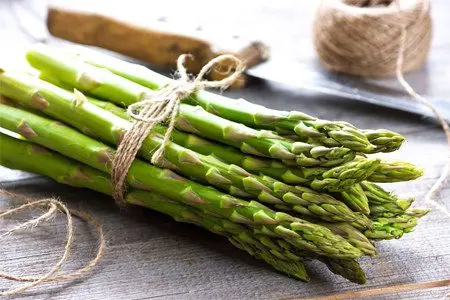
Statistics show that more than 1,3 billion people suffer from high blood pressure, which is the main cause of severe heart disease and strokes. To normalize blood pressure, two conditions are necessary – sufficient intake of potassium and restriction of salt intake.
Potassium has a relaxing effect on the walls of blood vessels and removes excess salt along with urine. 150 g of asparagus contains 6% of the daily requirement of potassium.
Experiments with laboratory animals have confirmed that the introduction of asparagus into the diet reduces blood pressure. For 10 weeks, a group of rats were fed a 5% asparagus diet. The analysis showed a reduction in blood pressure by 17% compared to the control group who received a normal diet. [7].
It is assumed that the hypotensive effect of asparagus is associated with active phytocomponents in its composition.
Although no human studies have been conducted, eating potassium-rich asparagus is known to help maintain normal blood pressure levels.
4 Asparagus helps in weight loss

The fact is that there are only 150 calories per 20 grams of asparagus. Even if the daily portions consumed are quite large, the body receives a negligible amount of calories.
Asparagus is 94% water. Observations of nutritionists suggest that the presence in the diet of low-calorie foods with a high content of water contributes to weight loss.
Due to its high fiber content, asparagus is considered a food that can speed up the process of losing weight and increase the amount of fat burned. Asparagus is recommended as a snack. It is recommended to be combined with a hard-boiled egg to enhance fat-burning properties. It maintains a feeling of satiety for a long time, facilitates bowel cleansing.
5 Asparagus helps fight urinary tract infections
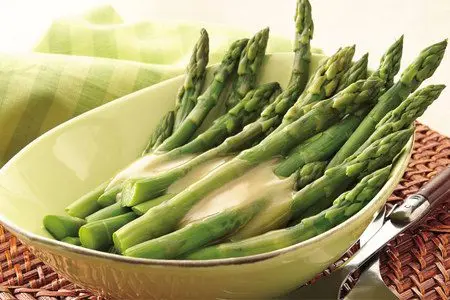
Aspartic acid is an active amino acid, which is rich in asparagus, has a diuretic effect. The use of large portions of asparagus shoots ensures the removal of excess fluid and salt from the body. This property can be considered preventive against urinary tract infections (UTIs).
Gynecologists believe that UTIs are more likely to develop in women with infrequent urination. Asparagus makes you go to the toilet more often, which means it stimulates the excretion of pathogenic flora from the urinary tract.
6 Provides the body with valuable vitamin E
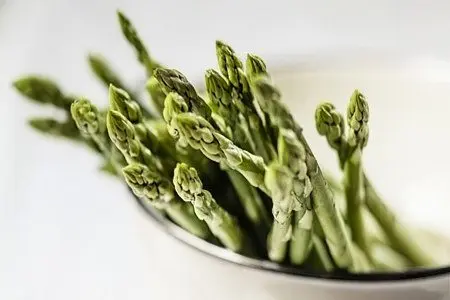
Vitamin E is a powerful antioxidant that protects cells from the negative effects of free radicals, strengthens protective functions. Known anti-aging properties of tocopherol, due to which it is also called the vitamin of youth. To maximize the properties of vitamin E, it is recommended to cook asparagus with a small amount of olive oil. The fact is that the full absorption of vitamin E occurs in the presence of fat.
7 Helps manage hangover symptoms

After a stormy party, accompanied by large portions of alcoholic beverages, the body simply craves fatty foods. An asparagus dish can be the best breakfast option to alleviate negative effects.
Laboratory experiments have shown that asparagus extract contains minerals and amino acids that protect liver hepatocytes from toxic ethanol compounds. The data was published back in 2009 in the Journal of Food Science. [8].
8 Asparagus fights bloating

Bloating is a problem that is difficult to manage. Asparagus can help. It contains soluble and insoluble fiber fibers that stimulate the digestion of food. It has been proven that prebiotics are present in the composition of the shoots, which are necessary for maintaining a healthy intestinal microbiota. It is the balance of probiotics that helps reduce gas formation. The removal of excess fluid also has a positive effect on the condition of the intestines and eliminates the symptoms of flatulence.
9 Is an excellent source of vitamin K
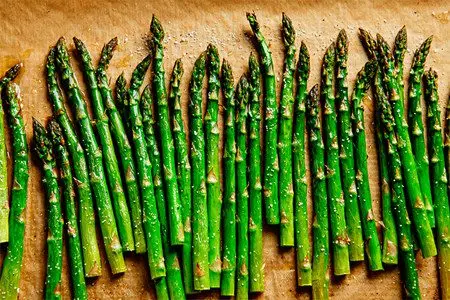
Asparagus, like other leafy vegetables, contains high dosages of vitamin K, 52% of the daily requirement per 150 g. This vitamin is necessary for normal blood clotting, without which it would be impossible to stop bleeding. In addition to affecting the qualitative composition of the blood, vitamin K is involved in the process of calcium absorption. Complete and proper absorption of calcium ensures the strengthening of bones, increasing their mineral density.
10 Asparagus is good for stomach ulcers
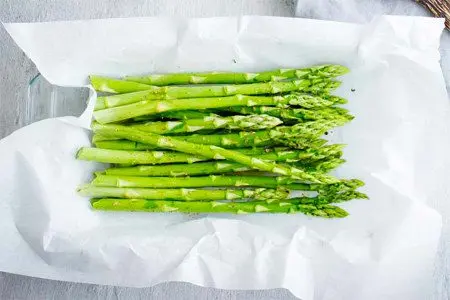
Asparagus shoots are an essential component of the diet for people diagnosed with stomach ulcers. The fact is that asparagus has a record content of vitamin U – depending on the type of plant, its concentration varies from 100 to 250 mg per 100 grams of the product, which is 10 times more than in cabbage. Vitamin U is called anti-ulcer, due to its incredible ability to heal damaged mucous membranes of the gastrointestinal tract. It is effective for the relief of heartburn attacks, as well as in the treatment of gastritis, gastric and duodenal ulcers.
11 Asparagus is a great mood booster
It has been proven that irritability and depression are the result of a deficiency of vitamin B12 and folic acid. Asparagus contains these valuable substances in abundance. In addition, it turned out that it contains a lot of tryptophan, an amino acid responsible for our psycho-emotional mood.
After studying the composition of asparagus shoots, it began to be recommended to patients with depression. Regular consumption of the product in large portions helps to get rid of deficient conditions and significantly improve the quality of life.
[Video] Why is asparagus so useful and valuable?
How to cook delicious asparagus?
Before you start cooking asparagus, the shoots are washed and cleaned with a vegetable peeler. White asparagus is cleaned under the top, and green asparagus is cleaned along the entire length. The bottom edge is cut off a couple of centimeters.
Asparagus stalks are collected in a bunch of 8-10 pieces. A piece of butter is added to boiling, salted water, after which the lower part of the shoots is lowered, which are distinguished by significant stiffness and density. The steam rising up helps to cook the upper parts of the shoots.
Cooking time for asparagus is no more than 8 minutes. If you are using white asparagus, cook it for 15 minutes. Properly cooked asparagus will easily prick with a fork, but remain tender. The green asparagus is dipped in cold water immediately after being removed from the pot to help maintain its attractive color.
Pickled asparagus
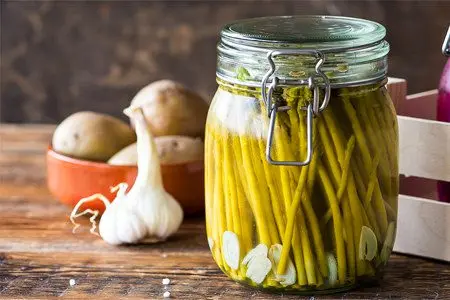
Prepared asparagus shoots are placed in boiling water and blanched for about 4 minutes. After that, the stems are taken out with tongs and laid out in a container filled with ice cubes or cold water.
For the marinade take:
2 st. spoons of soy sauce.
2 tbsp. tablespoons of sesame oil.
1 st. a spoonful of rice vinegar.
1 teaspoon of sugar.
Dry the asparagus with paper towels, put it in a wide glass dish, pour the marinade and sprinkle generously with sesame seeds. The shoots are mixed with culinary tongs. The container is covered with cling film and placed in the refrigerator. After 2 hours, the finished pickled asparagus can be served at the table.
[Video] Pickled asparagus. Vegetable appetizer for nature or a festive table:









